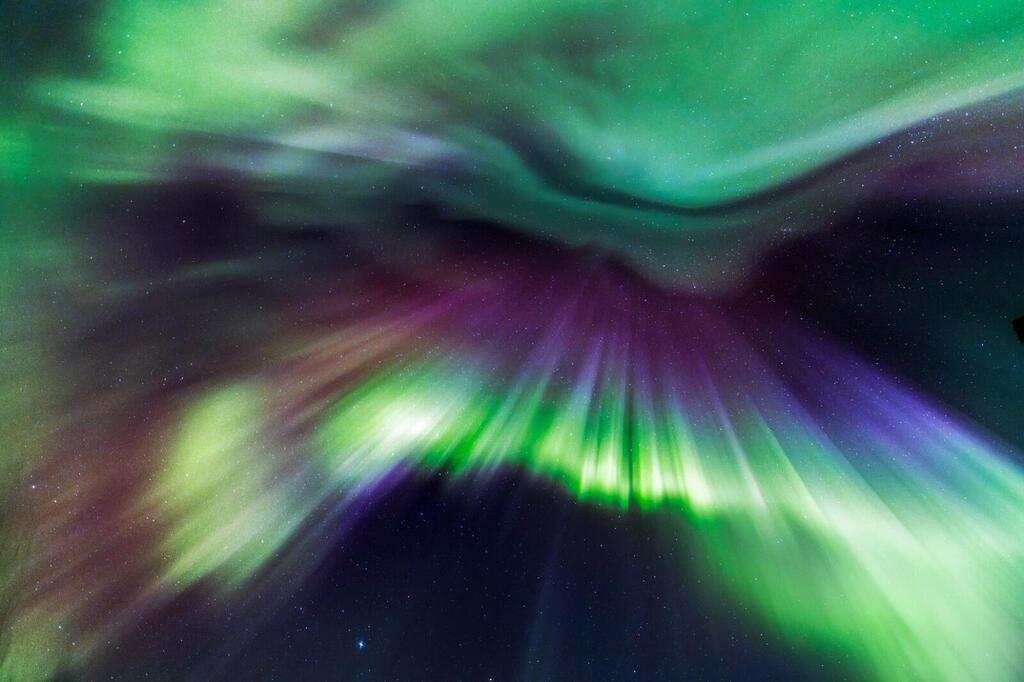“I have never seen such a powerful aurora; it was one of the strongest geomagnetic storms Iceland has seen in recent years,” says Roi Levi, an internationally awarded landscape and astronomical photographer. Levi recently returned from a photography tour in Iceland with impressive photos, some even shared on NASA’s Instagram account.
Nearly a year ago, Levi predicted that 2024 would be a peak year for observing the Northern Lights on Earth. “Aurora,” he later explained, “is the Latin word for the polar lights: the aurora borealis in the Arctic and the aurora australis in the Antarctic. They come from the sun, where explosions create geomagnetic storms. The solar wind then carries the particles to Earth, where they collide with our atmosphere and create colors, mostly green, but sometimes rare reds, purples, pinks and even blues. You can see almost the entire RGB spectrum: red, green, blue, pink and purple.”
Levi explains that solar maximum, the period of peak activity of the sun, occurs approximately every ten years, lasting about two years before dropping to a minimum. “We are currently in the fifth year of a solar maximum cycle,” he said, “and scientists believe it could last until the end of 2026. This year, we expect to see the strongest solar activity of the decade. It will be the best time to witness the aurora, with incredible, enhanced and colorful displays.”
Levi pointed out: “The next solar cycle, Solar Cycle 26, will begin in 2030, peaking in 2035. So anyone who doesn’t travel in the next year or two may have to wait about a decade to see such intense auroras.”
12 View the gallery


The Milky Way
(Photo: Roi Levi)
The scientists’ predictions, along with Levi’s, turned out to be true. “I’m still emotional about the geomagnetic storm we experienced,” he said, after returning from Iceland, where he led a photography tour. “We saw an aurora with a KP index of 8, just one step away from the maximum level of KP 9. The sky was at an intense storm level: the aurora was spiraling like a snail, forming coronas across the whole sky. It was a sight I had never seen, and this was my fourth trip to Iceland this year alone.”
12 View the gallery


12 View the gallery


12 View the gallery


Levi’s tours, limited to five participants, are physically demanding and not for everyone. “I have a rule: ‘Aurora before bed,’” he says. “I’ll make it clear right away: whenever there is aurora activity, we go wherever we need to go to photograph it, no matter how tired or cold we are. For example, on our first night in Iceland, there was only one free area in the southeast, near Diamond Beach, so we drove there, even though it took us seven hours. This was our routine for ten days, averaging around seven hours of driving per day.”
12 View the gallery


At night, while participants sleep five to six hours, Levi stays awake studying maps, planning his next location. “I told them a Polish mother’s saying,” she laughs, “‘Don’t worry, we’ll have plenty of time to sleep in the grave. Now is the time to live.'”
12 View the gallery


12 View the gallery


12 View the gallery


12 View the gallery


12 View the gallery


12 View the gallery


Few people are as passionate about solar explosions as they are about earthly ones, and Levi is undoubtedly one of them. “When I saw that there was a significant solar flare on September 10, I knew we would feel it here on Earth within two to three days. I checked the maps to see where it would be visible and we drove to those spots. Boom! We were in the right place: the sky was full of fast-moving lights. This time the aurora behaved differently, starting as pillar-like curtains that descended and then transformed into arching crowns, each in a circular motion. It went on like this all night and everyone on the beach couldn’t stop screaming with excitement. Even in the hotel, with the lights off, we could still see the magnetic activity in our minds. The colors stayed with us even as we tried to sleep; this storm was transformative: a once-in-a-lifetime experience.”
12 View the gallery


What is Levi’s future? “I don’t feel like I’ve reached my peak yet. I want to see the highest KP index, KP 9. This is my goal and, according to forecasts, we have until July 2025 to enjoy a strong Northern Lights before the current solar maximum ends.”
Download the Ynetnews app on your smartphone:
#Fascinating #Northern #Lights #amazes #veteran #photographer #Ive

